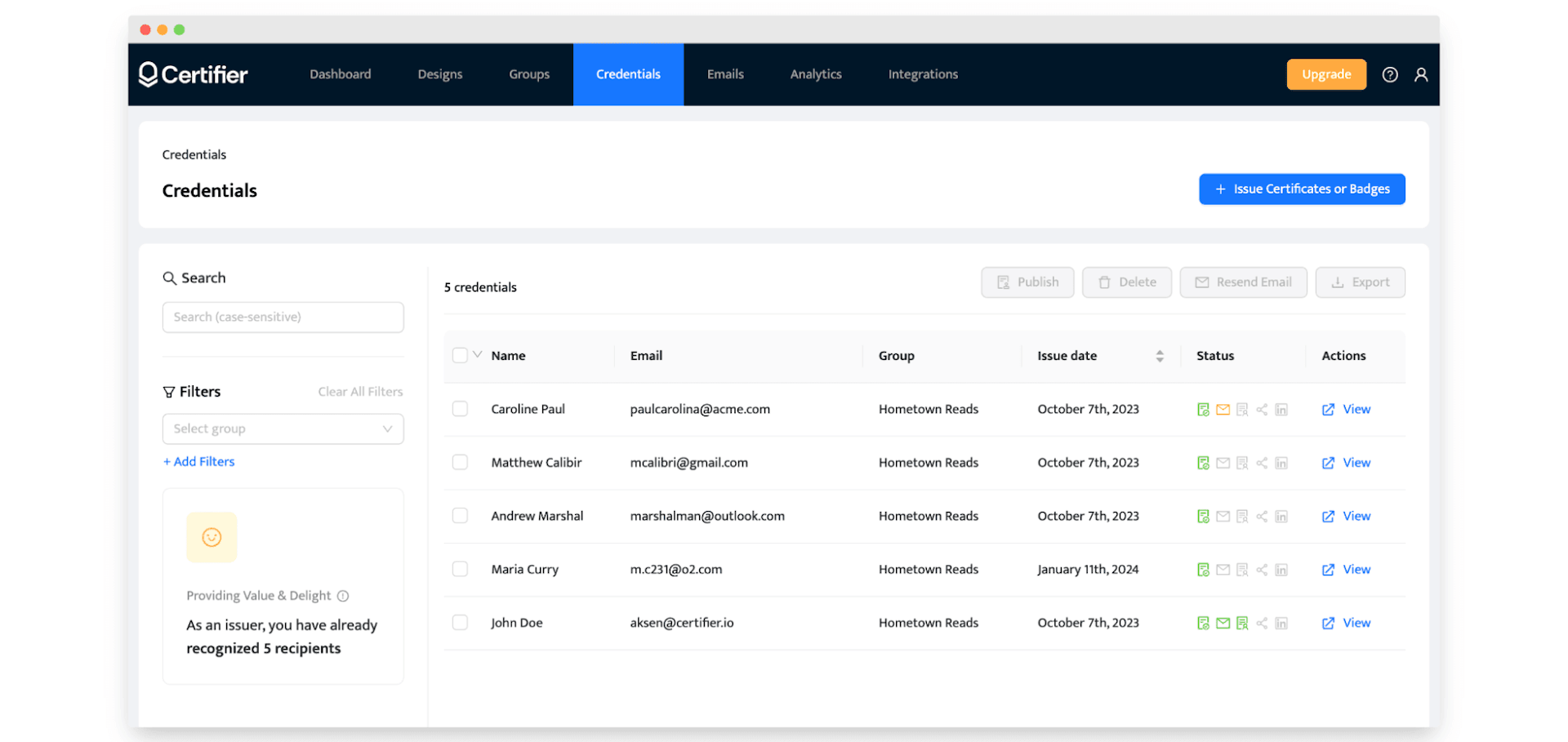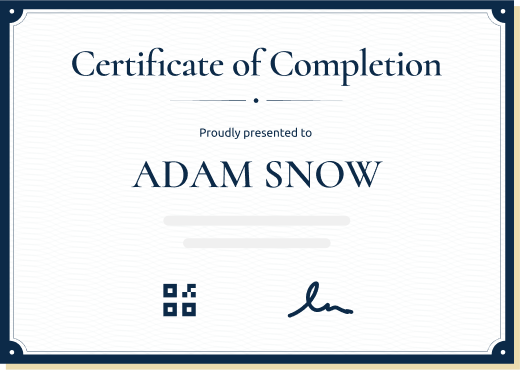Trusted by:
Types of Continuing Professional Education (CPE)
Find out what you need to know before offering Continuing Professional Education (CPE). Learn about the types of CPE. Correctly identify the right format for your company. Lastly, see how certifications can boost your professional development program outcomes. Don’t hesitate – start reading now.
AuthorOla Kozielska
Updated: April 03, 2024
9 min read

Author
Ola Kozielska
Updated: April 03, 2024
9 min read
Trusted by:
Are you part of an organization or an entity looking to join the current trends of offering Continuing Professional Education (CPE)?
Or maybe you're already on this path and seeking to expand your understanding?
Well, you're in the right place!
Since the body of knowledge on CPE isn't very big on the Internet, we've decided to change it.
Today, we're bringing you lots of great insights on this exciting topic and how you can make the most of it.
What should organizations know before offering CPE?
When it comes to offering Continuing Professional Education (CPE) courses, there's a lot for organizations to consider. Whether you're just starting out or looking to enhance your existing programs, understanding the key elements of successful CPE offerings is fundamental.
We’ve broken down what you need to know:
Understand your audience's needs
First things first, know your audience. Different professionals have varying career aspirations depending on their industry, stage, and personal goals. Conducting thorough research or surveys can help you tailor the current practice of your courses to meet these specific needs.
Compliance and accreditation
Compliance is king in the world of CPE. Make sure that your courses meet the industry standards and regulations. This might involve getting your courses accredited by relevant professional bodies. This can not only add credibility but also assure participants of the value and legitimacy of your courses.
Quality content is key
The heart of any CPE course is its content. High-quality, relevant, and engaging content is essential. This could mean collaborating with industry experts, using real-world case studies, or even incorporating the latest trends and technologies in your field.
Flexible and accessible learning options
These days, flexibility is a must. Offering online courses, on-demand content, and flexible scheduling can make your CPE courses more accessible and appealing to busy professionals.
Continuous improvement and feedback
Finally, always be open to feedback. Regularly updating your courses based on participant feedback and industry changes will keep your offerings fresh and relevant.
Continuous improvement is the way to staying ahead in the competitive world of professional education.
Keep these points in mind. Thanks to them, your organization can create effective and impactful CPE courses. They will not only meet the needs of professionals but also enhance your reputation as a quality education provider.
Types of CPE programs
Continuing Professional Education (CPE) programs come in various formats. Usually, each of them caters to different learning styles and professional needs. Understanding these types can help you design and offer the most effective and engaging CPE courses.
Let's explore some of the popular types of CPE programs:
Educational partnerships
Collaborating with academic or training institutions can enhance the quality and credibility of CPE programs.
This could entail:
Collaborations with academic institutions: partnering with universities or colleges to offer specialized courses or certifications. Tip: Use Certifier to create customizable CPE certifications quickly and easily.
Specialized training programs: customized training developed in partnership with industry experts or educational bodies.
In-person training sessions
These are traditional face-to-face learning experiences.
They include:
Workshops: interactive sessions focusing on hands-on skills and group activities.
Seminars: more lecture-based, these sessions are great for introducing new concepts or theories.
Conferences: large gatherings with multiple sessions, ideal for networking and exposure to a wide range of topics.
Online learning platforms
The digital revolution has made online learning a staple in CPE.
This category involves:
Webinars: live online events, often with a Q&A session, providing an interactive learning experience.
Self-paced E-learning courses: these allow learners to complete modules at their own pace, ideal for busy professionals.
Virtual conferences: online versions of traditional conferences, offering a mix of live and recorded sessions.
On-the-job training
Practical experience is invaluable in professional development.
The examples are:
Mentoring programs: pairing up learners with experienced professionals for guidance and knowledge sharing.
Job shadowing: observing a professional in their daily work to gain insights into specific roles or industries.
How to identify the right CPE type for your organization?
You can do it easily.
All in a matter of just four steps.

Step 1: Identify target audience needs
Understand your learners
Begin by analyzing the specific needs, skills, and knowledge gaps of your potential learners. This could involve surveying your audience, studying industry trends, or consulting with professional associations on various degree programs.
Customize accordingly
Tailor your CPE programs to address these identified needs. This keeps your offerings directly relevant and beneficial to your audience.
Step 2: Align with accreditation standards
Stay compliant
Make your CPE courses adhere to the credit requirements set by relevant professional bodies. This not only adds credibility but also helps keep your courses recognized and valued in the industry.
Regular updates
Keep abreast of any changes in accreditation standards and adjust your programs accordingly to stay compliant and relevant.
Step 3: Evaluate market demand
Market research
Conduct thorough research to understand the current market demand for CPE. Look into which areas of professional education are most sought after.
Emerging trends
Pay attention to emerging trends and shifts in the industry. Adapting your CPE offerings to these changes can position your organization as a forward-thinking and relevant provider among regulatory bodies.
Step 4: Develop engaging content
Interactive and relevant
Create content that is not only informative but also engaging and interactive. This could mean adding case studies and real-world scenarios, as well as hands-on exercises.
Learner engagement
Focus on developing content that resonates with your audience and encourages active participation. The more engaged your learners are, the more effective the learning experience will be.
How can certification boost your professional development program outcomes?
Enhancing your professional development program courses is crucial, and certifications can play a big role here.
Certifier is your go-to solution for making this process seamless and impactful.
Are you curious to know how we do it?
Let's see how we can revolutionize your next learning activity.
Digital certificates and badges for lifelong learning
Certifier lets you create digital certificates and badges effortlessly.
These aren't just ordinary certificates – they're designed to reflect the professional competency gained through your courses.
They're perfect for practice-based learning environments and can be customized to align with specific credit hours or educational activities.
Streamlining the certification process

Certifier simplifies the certification process in your education activities:
Design: choose from a plethora of templates or create your own to reflect the essence of your education programs.
Issue: efficiently distribute certificates and badges in bulk.
Analyze: monitor how recipients interact with their certificates to foster an active learning environment.
Beyond certificate creation
We offer more than just certificate generation. Among the features of our certification software, you’ll find:
Bulk generation: generate and send hundreds of certificates with ease, perfect for large-scale educational activities.
Custom branding: tailor certificates to your organization’s branding to enhance the professional appeal.
Integration: seamlessly integrate with existing systems to meet various education requirements.
Security: securely manage certificates to easily comply with GDPR and other regulations.
The impact on professional organizations
When you incorporate Certifier into your CPE courses, you're not just issuing certificates. In fact, you're elevating the overall quality and appeal of your programs.
This leads to more engaged participants, higher completion rates, and enhanced recognition from professional organizations.

All in all, Certifier is an excellent tool for anyone committed to providing quality education and continuous learning opportunities.
We make every education credit earned not only recognized but also respected in the professional community.
Ready to take your CPE program to the next level? Explore Certifier and be the witness of your transformation in your educational approach!
Bonus: Free CPE certificate templates to download
What if you can get a CPE certificate template for Figma or Word for free? The Certifier library provides many CE certificate templates that you can customize however you want to. Just click on the button. Don't miss them out (they're all free!).

Please note: If you want to customize the templates, create a Certifier account. You get access to a visual editor that allows you to customize each template however you want to.


Conclusion
Alright, that's a wrap!
We've explored the exciting world of Continuing Professional Education together.
From getting to know what your audience really wants to the cool ways Certifier can jazz up your courses with certifications.
Remember: the secret to a great CPE program is understanding your learners, keeping up with the rules, and always being ready to mix things up based on feedback.
So, take these tips and give your CPE programs a little extra sparkle. Do it with Certifier – create a free account today. We’re here to help.
FAQ

Ola Kozielska
Content designer. At Certifier, Ola crafts user-friendly content that makes complex information easy to grasp.
Ola Kozielska
Content designer. At Certifier, Ola crafts user-friendly content that makes complex information easy to grasp.
Share this article